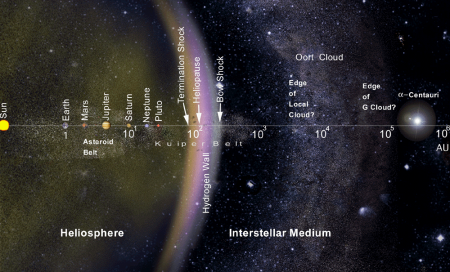NASA’s Voyager 1 Is Preparing To Leave Our Solar System. So Glorious.
NASA’s Voyager 1 has been rummaging around the solar system since 1977. 19-fucking-77! That’s a considerable amount of time, and it has grown bored of this little portion of the galaxy. Soon, soon indeed!, it’s going to bid adieu to our solar system. That’s right, the first man-made object is about to leave the Sun’s domain. Incredible.
io9:
When NASA’s Voyager 1 spacecraft launched from Cape Canaveral, Florida in 1977, its primary mission was to explore Jupiter and Saturn, the largest planets in our solar system. On November 16, 1980, the spacecraft captured this photograph of Saturn from a distance of just 5.3-million kilometers.
Four days later, Voyager 1’s primary mission drew to a close – but its journey was just beginning. For over three decades, the 1600-pound space probe has been putting distance between itself and the Sun at speeds approaching 11 miles per second, in the process becoming the most far-flung object we’ve ever put in space. And now, at a distance of close to 11 billion miles from the Sun, NASA says Voyager 1 is on the verge of leaving our Solar System forever.
When it does, Voyager 1 will become the first man-made object to soar through what astronomers refer to as the interstellar medium, the matter that makes up the regions of space interspersed between our galaxy’s scattered star systems.
“Voyager tells us now that we’re in a stagnation region in the outermost layer of the bubble around our solar system,” explains Ed Stone, the Voyager project scientist at Caltech. “[It’s] showing that what is outside is pushing back. We shouldn’t have long to wait to find out what the space between stars is really like.”
The bubble that Stone is referring to is what astronomers call the heliosphere, a region dominated by streams of solar wind (charged, subatomic particles emitted by the Sun). The farther from the Sun you get, the weaker these winds blow, allowing high-energy electrons from interstellar space to leak into the heliosphere and “push back,” so to speak, on the Sun’s solar wind. The point where pressure from the solar wind and the interstellar medium balance is known as the the heliopause, and is the cosmic signpost demarcating where our Solar System ends, and interstellar space begins.
“We’ve been using the flow of energetic charged particles at Voyager 1 as a kind of wind sock to estimate the solar wind velocity,” explained Rob Decker, a co-investigator for Voyager’s low-energy charged particle instrument at Johns Hopkins Applied Physics Lab. “We’ve found that the wind speeds are low in this region and gust erratically. For the first time, the wind even blows back at us. We are evidently traveling in completely new territory.”
Stone says that the transition to the interstellar medium may not be instantaneous, and that it may in fact take months to traverse what he describes as “a rather messy interface” between the two opposing winds. Nevertheless, he’s confident that the crossover into interstellar space is indeed imminent – and that’s a good thing; NASA suspects that the probe only has enough power to continue with its investigations for another 10–15 years.
Voyager, a man-made object. 11-billion miles from the Sun, about to leave our solar system. Humanity, I’ll drink to that.




